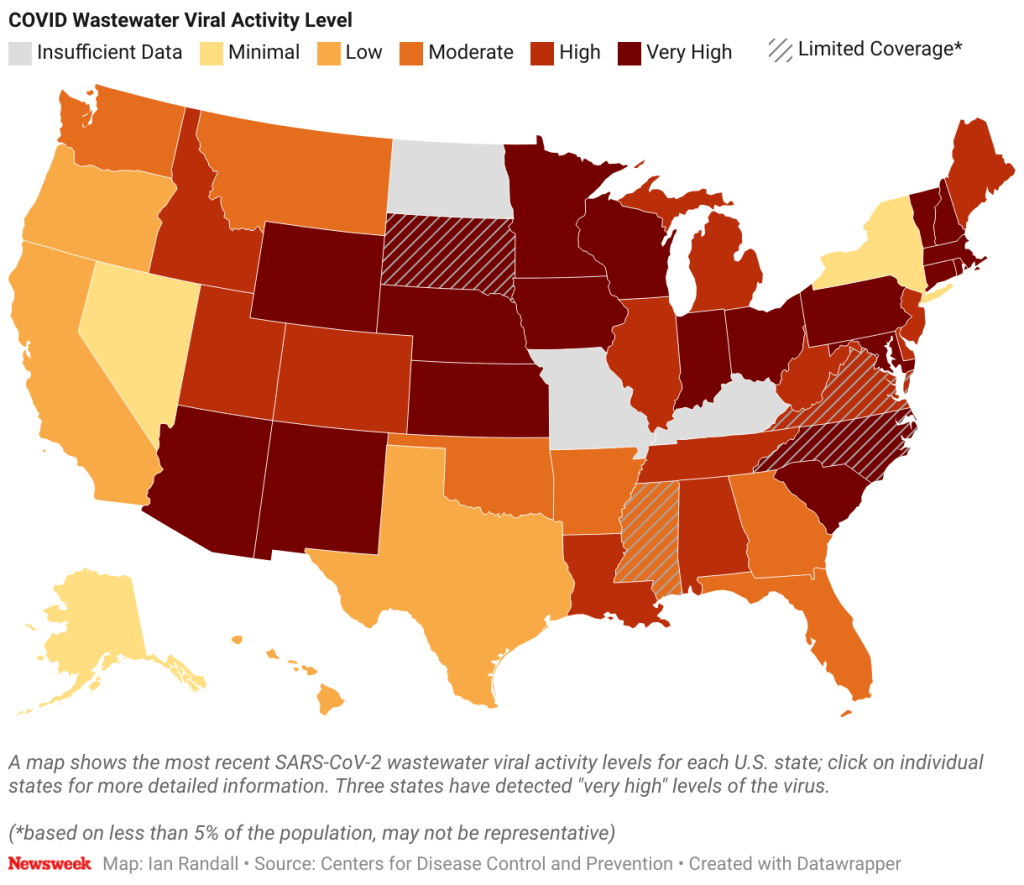The levels of COVID-19 present in wastewater around the country is on the rise, new data from the U.S. Centers for Disease Control and Prevention (CDC) reveals.
20 U. S. states (plus Washington DC) had “very high” levels of SARS-CoV-2, the virus that causes COVID-19, in wastewater during the week between December 29, 2024 and January 4, 2025.
This is an increase from last week, when states had “very high” levels of the virus.
“Wastewater (sewage) can be tested to detect traces of infectious diseases circulating in a community, even if people don’t have symptoms,” the CDC explains.
According to data from the CDC, Arizona, Connecticut, Indiana, Iowa, Kansas, Maryland, Massachusetts, Minnesota, Nebraska, New Hampshire, New Mexico, North Carolina, Ohio, Pennsylvania, Rhode Island, South Carolina, South Dakota, Vermont, Wisconsin and Wyoming, as well as Washington D. C. , all had “very high” levels of the virus in their wastewater this time around.
A week ago, between December 15 and 21, 14 states had “very high” degrees, and before that, between December 8 and 14, five states had “very high” degrees of the virus.
Alabama, Colorado, Delaware, Idaho, Illinois, Louisiana, Maine, Michigan, New Jersey, Tennessee, Utah, Virginia and West Virginia had “high” levels of COVID-19-related wastewater, while Arkansas, Florida, Georgia, Mississippi, Montana, Oklahoma and Washington all had “moderate” degrees.
California, Hawaii, Oregon, and Texas had “low” levels, and Alaska, Nevada, and New York had “minimal” levels.
Kentucky, Missouri and North Dakota have no data available for this period.
Additionally, North Carolina, South Dakota, Mississippi and Virginia have “limited coverage” for this week’s data, which according to the CDC, means that their viral activity level is “based on a small part (less than 5 percent) of the population and may not represent viral activity levels for the entire state or territory.”
Wastewater samples are collected from treatment plants or other community sources, and are tested for SARS-CoV-2 RNA, offering a snapshot of virus levels in the population.
This wastewater surveillance provides early warning of COVID-19 trends in a community, as individuals can shed the virus in their feces even if they are asymptomatic or untested.
Therefore, this can help the CDC monitor entire communities, regardless of medical care or testing, and detect changes in the prevalence of COVID-19, potentially predicting surges.
CDC testing data for the same period reveals that 6.9 percent of COVID-19 tests came back positive, with the highest test positivity rates across Illinois, Indiana, Michigan, Minnesota, Ohio and Wisconsin.
“Many respiratory viral illnesses peak in the winter due to environmental situations and human behaviors,” a CDC spokesperson previously told Newsweek.
“COVID-19 increases in the winter and throughout the seasons, including summer, due to new variants and decreased immunity from past infections and vaccines. “
Do you have a recommendation for a science topic Newsweek covers? Do you have any questions about comets? Let us know at science@newsweek. com.
Jess Thomson is a Newsweek science journalist based in London, UK. It focuses on informing about science, generation and health care. He has extensively covered animal behavior, area news, and the effects of climate change. Jess joined Newsweek in May 2022 and previously worked at Springer Nature. He graduated from the University of Oxford. Languages: English. You can contact Jess by emailing j. thomson@newsweek. com.

